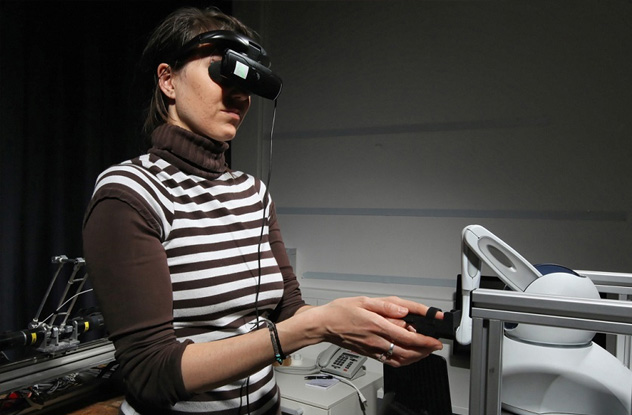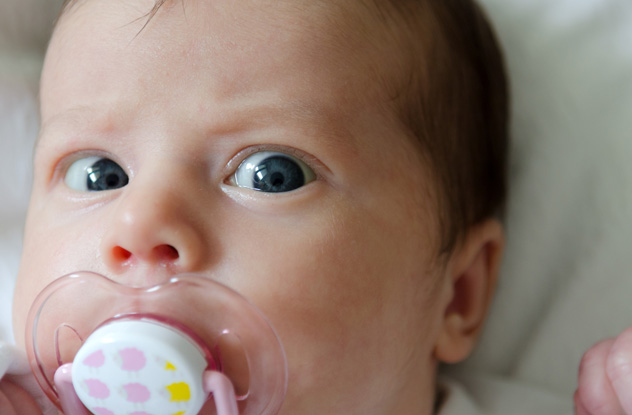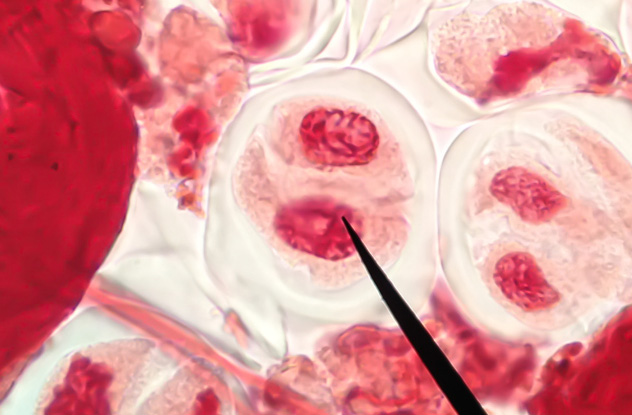 Animals
Animals  Animals
Animals  Health
Health 10 Things Your Poop Is Trying to Tell You
 Music
Music 10 Musical Instruments Invented in the 21st Century
 Food
Food 10 Mouthwatering Desserts That Will Satisfy Your Sweet Tooth
 Crime
Crime Ten 21st-Century American Serial Killers Who Got Away with It
 Creepy
Creepy 10 Creepy Omens That Foretold a Royal Death
 Weird Stuff
Weird Stuff Top 10 Weirdest Attractions at Coney Island
 Health
Health 10 Ancient Prosthetics That Deserve a Hand
 History
History 10 Tragic and Shocking Facts about the White Ship Disaster
 Our World
Our World 10 Bizarre Scientific Theories That Experts Are Seriously Considering
 Animals
Animals 10 Absurd Times That Animals Have Run Amok
 Health
Health 10 Things Your Poop Is Trying to Tell You
 Music
Music 10 Musical Instruments Invented in the 21st Century
Who's Behind Listverse?

Jamie Frater
Head Editor
Jamie founded Listverse due to an insatiable desire to share fascinating, obscure, and bizarre facts. He has been a guest speaker on numerous national radio and television stations and is a five time published author.
More About Us Food
Food 10 Mouthwatering Desserts That Will Satisfy Your Sweet Tooth
 Crime
Crime Ten 21st-Century American Serial Killers Who Got Away with It
 Creepy
Creepy 10 Creepy Omens That Foretold a Royal Death
 Weird Stuff
Weird Stuff Top 10 Weirdest Attractions at Coney Island
 Health
Health 10 Ancient Prosthetics That Deserve a Hand
 History
History 10 Tragic and Shocking Facts about the White Ship Disaster
 Our World
Our World 10 Bizarre Scientific Theories That Experts Are Seriously Considering
10 Bizarre Ways Your Sense Of Touch Changes How You Think
Our brains are constantly processing information from our senses to make us understand who we are and what we feel. When those physical mechanisms don’t work as expected, especially with the sense of touch, our minds can play bizarre and sometimes dangerous tricks on us.
10Mirror-Touch Synesthesia

Synesthesia is an unusual condition that is believed to result from the tangling of our senses. The stimulation of one sense triggers another. For example, some people taste words or see letters as colors. It’s possible that some forms of synesthesia are learned. A 2015 study found that children who played with colored plastic letters, especially the magnetic kind that stick to a refrigerator door, were more likely to become synesthetes who saw letters as colors.
With an even more bizarre form of this condition, mirror-touch synesthesia, the synesthete feels the touch that he or she sees happening to someone else. In this form of synesthesia, many scientists believe that the affected person’s brain has overactive mirror neurons, cells that help us to understand and sometimes feel the experiences and emotions of others.
For one woman with mirror-touch synesthesia, the side of her body where she felt the touch changed according to how she viewed the other person. If she was facing someone who received a touch on the left cheek, she experienced the same touch on her right cheek. However, if she was standing side by side with that person, she would feel the touch on the other’s person left cheek on own her left cheek.
Mirror-touch synesthesia appears to make a person more empathetic than average. As one mirror-touch synesthete described it: “I have never been able to understand how people can enjoy looking at bloodthirsty films, or laugh at the painful misfortunes of others when I cannot only not look but also feel it.”
9The Ghost Illusion

We’ve previously discussed how doctors unexpectedly produced a creepy shadow person that mimicked the movements of a woman being prepared for epilepsy surgery. The woman sensed a presence when doctors electrically stimulated her left temporoparietal junction, the part of her brain linked to self-perception. Not realizing that her shadow person was an imagined double of herself, she believed that she was being watched and that the shadow person was trying to interfere with her activities. The effect ended when the electrical stimulation did.
In a more recent experiment, researchers used a robot to make some mentally and physically healthy participants feel a ghostly presence nearby when nothing was actually there. The participants’ brains tried to make sense of a mismatch between their senses by creating the illusion of a ghost.
While blindfolded and wearing headphones, the participant was asked to stand between two robots. Then the participant would tap the robot in front, which caused the robot in back to touch her back in an identical move. This made the participant feel as though she was reaching forward to tap her own back.
In the next phase of the experiment, when the participant tapped the robot in front, the robot in back would briefly hesitate before touching the person’s back. As the person’s brain tried to determine the mismatched sensation’s origin, it created the illusion of a ghost’s touch. “For some, the feeling was even so strong that they asked to stop the experiment,” said neuroscientist Giulio Rognini.
In both of these cases, researchers believe that even a small distortion of the delicate balance between our brains’ perceptions of self and others led to experiences that may explain what happens to people who suffer from schizophrenia, hallucinations, and other symptoms of mental illness.
8The Hug Brain Test

Rather than rely on a person’s behavior or description of their symptoms, scientists are trying to devise medical tests that can more objectively diagnose psychiatric conditions. Marcel Just of Carnegie Mellon University has been researching how to use fMRI and other technologies to map the effects of human thought on the brain. By asking participants to imagine types of social communication such as hugging, Just has used an fMRI scanner to identify people with autism with a 97-percent success rate.
“When asked to think about hugging or adoring, the neurotypical participants put themselves into the thoughts; they were part of the interaction,” said Just. “For those with autism, the thought was more like considering a dictionary definition or watching a play—without self-involvement.”
This type of procedure has revealed that certain emotions and thoughts activate specific patterns of neurons in the brain. Thought-markers, or departures from these established patterns, may be helpful in diagnosing mental illness. Besides using this with autism, Just is trying a similar approach to diagnosing other types of psychiatric disorders.
7Deaf People Hear Touch
When someone loses a sense, the brain rewires itself to compensate. MRIs have shown that deaf people sense touch with the hearing part of their brains, also known as the Heschl’s gyrus in the auditory cortex. To a lesser extent, deaf people also use this part of the brain to process visual cues. Researchers believe their studies suggest that deaf students can learn to read or do math using their sense of touch.
Scientists are continuing to develop new technologies to help the hearing-impaired. As a less-expensive alternative to cochlear implants, which currently cost over $40,000, researchers recently developed a smart retainer/earpiece instrument that converts words heard by the earpiece into distinct tactile sensations felt by the tongue. The device uses a 9-volt battery to avoid electrocuting the patient.
The goal is to rewire the brain to associate those sensations with specific words and allow the partially deaf person to hear with his or her tongue. It’s similar to a blind person associating words with the patterns of bumps used in Braille.
The tongue was chosen because it’s hypersensitive. “Some people suggest it feels like the sensation of having champagne bubbles or Pop Rocks on their tongue,” said mechanical engineer John Williams.
6Startle Disease

Sometimes, normal touch affects our brains in odd ways. For example, a simple touch can produce seizures in babies with hyperekplexia (“startle disease”). Any unexpected movement or loud noise has the same effect. The muscles in their throats and chests freeze, while their legs and arms become stiff. Sometimes, they’ll stop breathing. If someone tries to comfort the baby and ease the reaction, the symptoms usually become worse.
Hyperekplexia is a neurological disease that’s often misdiagnosed as epilepsy. Caused by mutations in two genes, hyperekplexia is an exaggerated startle reflex that doesn’t resolve normally. These genetic mutations change how the glycine molecule, which reduces a person’s response to sound, moves between cells. The nerve cells don’t communicate with each other correctly.
For one child, the symptoms started at three hours old. “I’d felt abnormal movements and vibrations in my tummy during pregnancy, sometimes 10 times a day,” said her mother, Abbie. “Then when she was born, she had her first seizure, went a bit blue, and shook from head to toe. It was very frightening.” The baby would have attacks if breastfed, out of breath, or surprised. In the most extreme cases, startle disease can trigger sudden infant death.
If there’s a bright side, it’s that hyperekplexia usually becomes much less severe after the child’s first birthday. However, some adults do suffer from the disease, which can cause them to fall unexpectedly and possibly even die.
5A Link Between Touch And Emotions

Sensations don’t necessarily feel pleasant or unpleasant on their own. Instead, we respond to them according to emotional associations. This is because the primary somatosensory cortex, the region of the brain that responds to touch, also processes emotional factors.
In a 2012 study, researchers showed heterosexual men videos of either a pretty woman or a macho man caressing a leg. Simultaneously, an unseen figure touched the subject’s actual leg. Subjects who watched the tape of the woman found the touch pleasurable, while those who watched the tape of a man did not—even though the touch was identical (a woman touched the subject in each case).
“Intuitively, we all believe that when we are touched by someone, we first objectively perceive the physical properties of the touch—its speed, its gentleness, the roughness of the skin,” said researcher Valeria Gazzola. “Only thereafter, in a separable second step based on who touched us, do we believe we value this touch more or less.” The experiment disproved that assumption.
This type of study may lead researchers to develop methods of helping autistic people respond more positively to gentle touches from family members. It may also lead to related treatments for victims of abuse and torture.
4The Perception Of Pain

We can lessen pain by touching the hurt area and giving our brains feedback about the state of our bodies. Clenching your hand may also significantly relieve acute pain. A lot of us know this from experience and instinctively rub our head when we bump it without knowing why.
To study why self-touch may ease pain, researchers conducted an experiment using the thermal grill illusion. Participants put the second and fourth fingers of each hand in hot water while chilling the middle finger of each hand in cold water. By tricking the brain with different temperature signals coming from the fingers of the same hand, each participant experienced the illusion that their cold middle fingers were painfully hot.
When the participants were told to press the fingers of their hands together, they experienced a 64-percent drop in the pain from their middle fingers. It didn’t work if someone else touched their fingers. That suggested to the researchers that the brain was doing more than interpreting feedback about the temperature of the participants’ fingers. It was also creating an overall representation of the body. “In other words, self-touch affects how the brain represents the current state of the body,” said Marjolein Kammers of the University College of London, “and that can influence the way we experience pain.” It may also lead to better methods of treatment.
In an earlier experiment at the University of Oxford, scientists found that both pain and swelling in a patient’s hand could be changed by making the hand appear larger or smaller to the patient. When viewing their hands through binoculars that magnified size, patients sensed more pain and took longer to feel normal again. They also experienced more swelling of their fingers. Conversely, when the binoculars shrunk the image of their hands, patients experienced less pain and swelling. Researchers believe that people take less ownership of a body part that appears to be smaller than they were expecting.
3Cellular Changes From Meditation

In a surprising study, emotionally distressed breast cancer survivors who practiced mindful meditation and yoga or were involved in support groups maintained the length of their telomeres, the repeating DNA sequences at the end of chromosomes. Survivors who didn’t engage in these activities had shorter telomeres. Longer telomeres are linked to slower aging of cells and protection against disease. When a telomere is too short, the associated chromosome (in a cell’s nucleus) can’t make any more copies of itself, and the cell dies.
You can think of cellular aging like an old-fashioned clock that you wind by hand. As long as the clock keeps ticking, the cell lives by producing new cells. But when the clock winds down, time stops and the cell dies. That’s why we want our telomeres to maintain their length.
“We already know that psychosocial interventions like mindfulness and meditation will help you feel better mentally,” said lead researcher Linda E. Carlson. “But now for the first time we have evidence that they can also influence key aspects of your biology.”
The study only lasted three months, so it’s not yet known how long this effect of maintaining telomere length will last.
2Touch-Back Technology

In a field called haptics, scientists want to integrate touch into the technologies that are part of our everyday lives. By using the virtual bump illusion, researchers discovered how the brain processes information from more than one finger at the same time. The virtual bump illusion occurs when your fingers feel forces along a flat surface that cause the illusion of bumps.
“Our big finding was ‘collapse’—the idea that separate bumps felt in separate fingers are nonetheless experienced as one bump if their separation happens to match that of the fingers,” said J. Edgar Colgate, an expert in touch-based systems. In other words, if you run your fingers over a flat screen with two virtual bumps, the brain may only perceive one bump if the bumps and the fingers are spaced uniformly. The coincidence tricks the brain and alters its perception of touch.
This will allow scientists to give the illusion of depth to flat screen technologies. In that way, blind people will be able to use touch screens, while flat screen keyboards will actually feel like 3-D keyboards.
The goal is to bring touch to the digital world by having the mind perceive a flat surface as having texture and shape. Your touch screen will touch you back.
1Body Swapping
In 2008, Swedish scientists designed experiments that convinced participants that they had swapped bodies with other humans or with mannequins. By having their brains manipulated through the use of touch, the participants experienced the illusion of being inside someone else’s body, even if the body was of the opposite sex.
In one experiment, two cameras were placed on the head of a dummy where human eyes would have been located. Then the human participant was fitted with virtual reality goggles that connected to the cameras on the dummy. The human saw what the dummy saw. So if the human participant and the dummy looked down at the same time, the human would see the dummy’s body as though he were seeing his own body.
Then the researcher used two sticks to simultaneously stroke the human’s and the dummy’s stomachs. Although the human participant couldn’t see his own body, he felt his stomach being stroked while watching the dummy’s stomach being stroked through the virtual-reality goggles. For the human, this created the strong illusion that the mannequin’s body actually belonged to the human participant.
The scientists concluded that the effect was real when they scared the participants into believing their swapped bodies were about to be slashed with a real knife. Even though it was the mannequin’s body that was about to be attacked, the participants exhibited stress reactions such as sweating. It was unclear what would have happened to a person’s psyche and sense of body ownership if the experiment had been continued for a prolonged period of time.
“This shows how easy it is to change the brain’s perception of the physical self,” said Henrik Ehrsson, who led the project. “By manipulating sensory impressions, it’s possible to fool the self not only out of its body but into other bodies, too.”
As much as body swapping may have sounded like science fiction, even to the researchers themselves in 2008, real head transplants (or body transplants depending on your point of view) are being contemplated in the present day.








